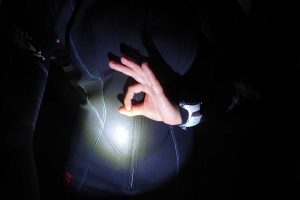Night diving is one of the thrilling and surprisingly beautiful things you can do as soon as you received your Open Water Certification. I would recommend doing the PADI Night Diver Specialty. This can also be counted as an adventure diver for your Advanced Open Water certification.
And lucky enough, you also have the possibility of doing night diving with us, at Scuba Center Asia.
Personally, my first experience with Night Diving was an experience where I said: “This was the first and also the last time I’ll do this.”
But stop, don’t let this scare you.
Luckily I learned from this experience and, stubborn as I am, wanted to give it another try. I did some research and now I can say I love night diving and it’s special critters. Let me explain in this blog for you exactly what I mean.
My first experience was in Thailand and gosh was my heart pumping big time there. I had the feeling I was constantly bumping into pinnacles and crashing into the corals. And I did not like the feeling of not knowing what would pop up into my light.
After this dive, I handled stuff a little bit differently and I would like to give you some tips, to make your first experience way more lovely as mine.
Equipment
There are a couple of things you need to do differently as when planning for a day-time dive. First and foremost is the equipment. Besides your normal diving gear (Mask, Exposure suit, BCD, Fins, Regulator, and Tank) you also want to bring an underwater flashlight. Also, it is important that you have a dive computer with backlighting and a compass and depth gauge that absorbs the light of your flashlight, making it able to read it in the dark. Don’t forget to take a back-up light with you.

Dive Site
It is important to know the dive site. This makes the dive a lot more pleasant. For me, this was the biggest mistake I made during my first night dive. It was a dive site in Thailand with a lot of Pinnacles and every time there was one popping up in the light, made me do a slight turn, to only see another wall/pinnacle popping up in my light. This made it an uncomfortable dive for me. The best way to not get surprised by this is to get a proper briefing about the dive site and/or for me the best way is: to dive there at least one time in daytime, before the actual night dive.
If you’re still feeling nervous for a night dive, what you can also do is dive during dusk instead of after the sunset when it’s already dark. This will let your eyes gradually adjust to the dark.
Here at Scuba Center Asia we dive at Lembongan bay, otherwise known as the Pontoon. This is an easy, shallow but still magnificent dive site. Perfect for some night diving.
Hand Signals
When it’s completely dark around you and you only have your and your buddy’s flashlight to see something, you can imagine that communicating is a little harder as in daylight diving. But nothing you can’t overcome and this is also one of the things you learn in the specialty night diver course. Your flashlight will now be the most important tool in your communication. You might use it to shine a light on your hand giving the signal or you actually signal with the light itself. Morse-code advanced so to say ☺.
For example to signal oke. You point your flashlight on your chest and make the normal “ok” signal in front of your chest (in the light). Or what you also can do is circle around with the light on the sea floor.

If you want your dive buddy’s attention underwater, you make a side to side motion with your light shining on the seafloor in front of your dive buddy. And if you want to point out something, you make a circular motion around the subject. Important is to not shine the light in your own or your buddy’s eyes.
Marine life
During the night dives the fish and most of the marine life that are swimming around you in the daytime, goes for shelter and some sleep in the cracks and under the corals. Finding these animals sleeping in the cracks, gives you the ideal opportunity to observe these. In exchange the predators and nocturnal animals come to life. At our dive site, the Pontoon/Lembongan Bay, you have the possibility to find some cool (macro) stuff. Some examples are:
Bobtail Squid, big crabs, parrotfish sleeping in the rocks, juvenile critters like the juvenile octopus or juvenile lionfish, peacock flounder fish, feather starfish start walking around and moray eels getting out of there caves.
And last but not least, another really cool thing you could experience here is a phenomenon called bioluminescence. In other words: Plankton lighting up underwater when you disturb them! A very cool, magic-like experience!


If you would like to know more or experience the night diving up here. Just give us a heads up. We are more than happy to answer your questions and/or plan a dive with you!
Happy Bubbles!
Written by
Tatiana Meijer, Dive Master Candidate at Scuba Center Asia


